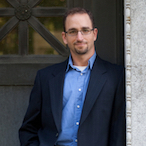Rob Bernard, Chief Environmental Strategist of Microsoft, gave a "Big Idea" talk at the State of Green Business Forum on cloud computing. Cloud computing has been cited as a great way to save energy across the grid. Bernard asked how many people thought they understood cloud computing. Of the roughly 200 people at the SOGB Forum, perhaps half raised their hands. Bernard quipped that that was pretty good--more than when he asks the IT folks.
Computing in the cloud, according to Bernard, gives us the possibility of high performance and unlimited storage. Many universities and large corporations actually run out of computing capacity. The amount of data that gets processed, for example, in climate modeling, takes about a month. To think about how much data that is, you might then begin to understand the challenge facing those Universities and corporations in attacking their energy usage. If you then add the fact that by having their own data processing facilities that need electricity to run, keep cool, store, protect, and maintain? Now you get the power of the cloud. So what is Microsoft doing?Bernard showed a photo of what looked like an abandoned parking lot with a canvas tent in the corner. He asked the group--"what do you see here?" The concept that this was the data center of the future (his answer) was not something that occurred to anyone in the crowd, given the collective "a ha" sounds emerging from around the room. Why does a data center have to be in a concrete building? According to Bernard it doesn't at all.
The coming smart grid will connect every point of electricity consumption to a central processing point. Cloud computing in this arena can help utilities manage the flow of demand. For instance, with everyone excited about electric cars, few are thinking about everyone coming home at 5 PM and plugging their car in when the summer heat is still high, and consequently crashing the grid.
Bernard said Microsoft is trying to tackle this and other problems, including the fact that much wind power generation is actually being dumped at night, because demand is low.
Stay tuned for more news from the State of Green Business Forum. As always, you can follow TriplePundit on twitter for live feeds from the event.
——————————————————–
Scott Cooney is the author of Build a Green Small Business (McGraw-Hill) and Principal of GreenBusinessOwner.com

Scott Cooney, Principal of GreenBusinessOwner.com and author of Build a Green Small Business: Profitable Ways to Become an Ecopreneur (McGraw-Hill, November 2008), is also a serial ecopreneur who has started and grown several green businesses and consulted several other green startups. He co-founded the ReDirect Guide, a green business directory, in Salt Lake City, UT. He greened his home in Salt Lake City, including xeriscaping, an organic orchard, extra natural fiber insulation, a 1.8kW solar PV array, on-demand hot water, energy star appliances, and natural paints. He is a vegetarian, an avid cyclist, ultimate frisbee player, and surfer, and currently lives in the sunny Mission district of San Francisco. Scott is working on his second book, a look at microeconomics in the green sector. In June 2010, Scott launched GreenBusinessOwner.com, a sustainability consulting firm dedicated to providing solutions to common business problems by leveraging the power of the triple bottom line. Focused exclusively on small business, GBO's mission is to facilitate the creation and success of small, green businesses.














